Reading time 6 minutes.
Istanbul was our first destination in Turkey, and the city where we spent the most time, about one week. What you are about to read is a slightly structured brain dump that does not match closely the Wikipedia page or any travel guide out there talking about Istanbul. I will fill the missing sections little by little because we are visiting Turkey at a strong pace and planning everything along the way. You’ve been warned!
History
The history of the city is incredibly rich and dates back six millenniums before Christ (BCE). I will simply mention the most common names it has been given. It was known as Byzantium even before the Greek settlement. Then, when it was taken by the (Eastern) Roman emperor Constantine the Great (323 CE) and became the capital of his empire (330 CE), it was named Constantinople, the City of Constantine. When it was conquered by the Sultan Mehmed II in 1453, it became the capital of the Ottoman Empire and was renamed Istanbul. The siege of Constantinople and the confrontation between the declining Roman Empire ruled by Constantine XI and the Ottoman Empire, is portrayed in the Rise of Empires: Ottoman Netflix series. We are currently watching it, mostly during transportation between cities, and even if the events are distant, it is very entertaining and resonate strongly with what we are experiencing. When the Republic of Turkey was founded in 1923 by Mustafa Kemal Atatürk, the capital was moved to Ankara. Istanbul is still the larger, the most populated city (over 15 million residents), and the main economic hub of the country.
Geography
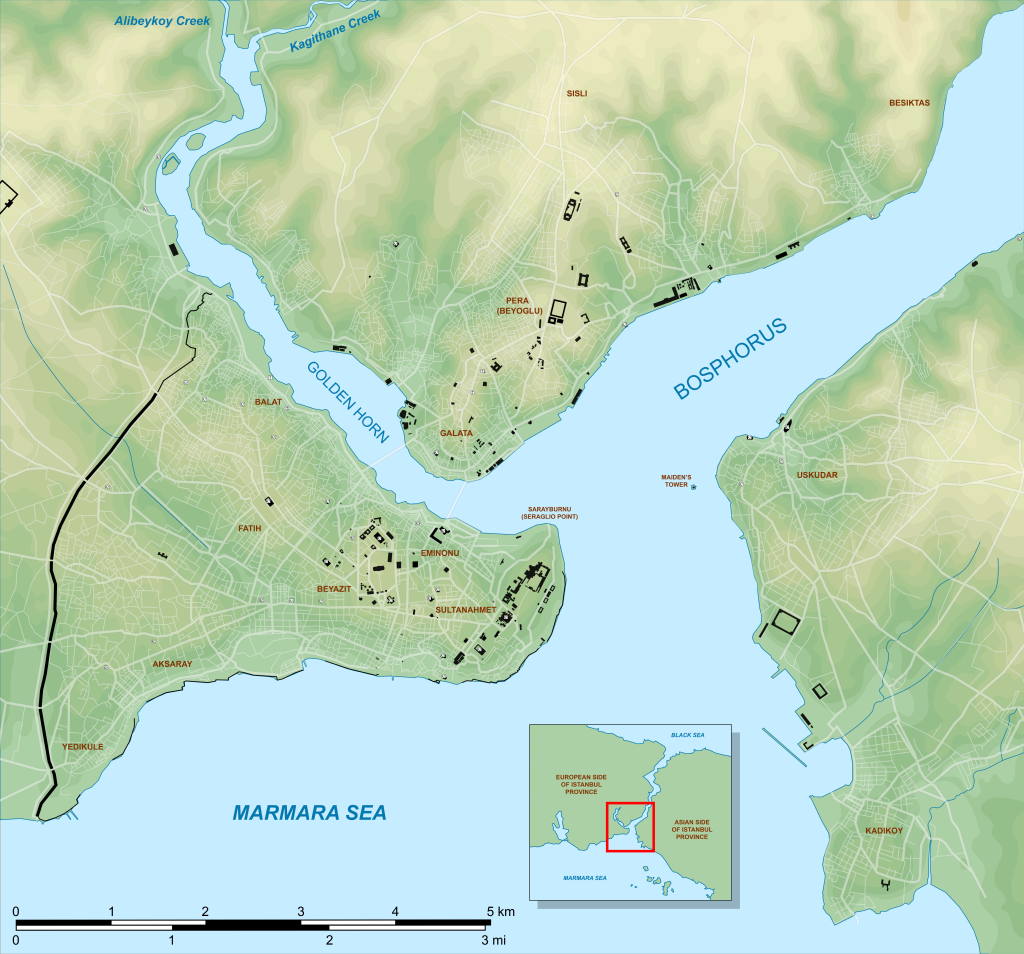
There are three main bodies of water around Istanbul: the Golden Horn, the Bosphorus and the Marmara Sea. The historical center, on the European continent, is located between the Golden Horn and the Marmara Sea. Almost all the historical buildings we have visited are located there. On the other side of the Golden Horn, still on the European side, you can find the popular districts of Beyoğlu and Karaköy. On the other side of the Bosphorus, in Asia, there is the district of Kadıköy. The walking tour guide said that “if Istanbul were New York, Kadiköy would be Brooklyn”.
Istanbul is known as the City on the Seven Hills. It is no coincidence because it was considered the new Rome, which is also a city built on seven hills. Istanbul has more than seven hills of course; it is very hilly everywhere I looked. The “seven hills” are inside the Theodosian Walls erected during the 5th century.
Bridges
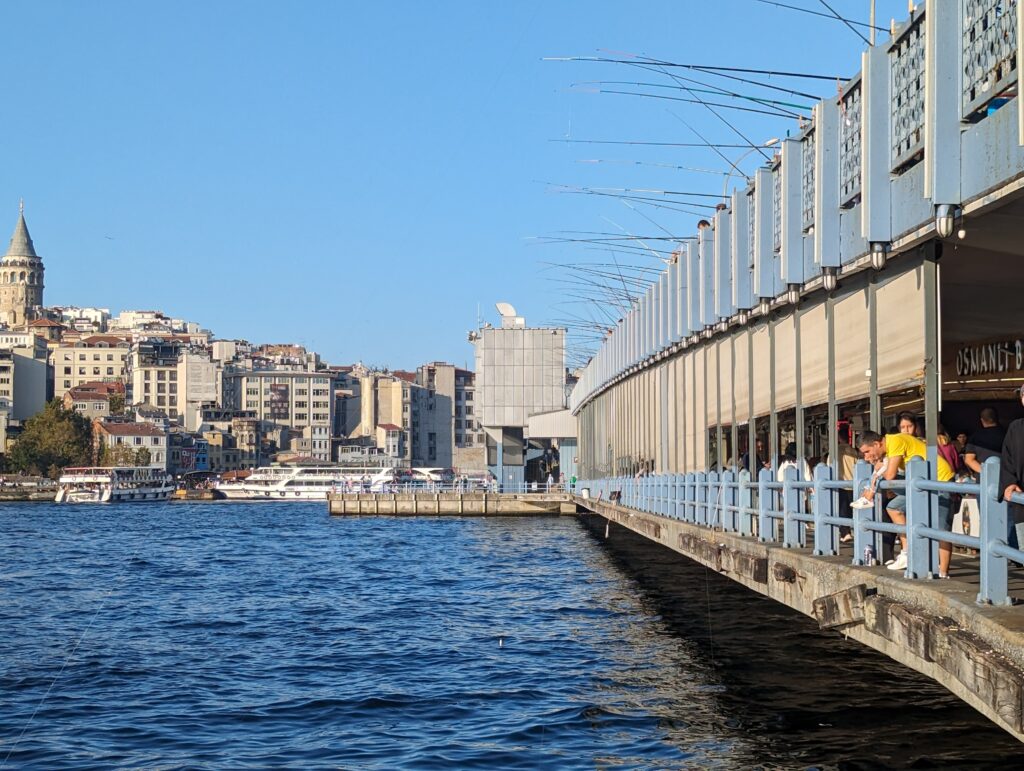
During my stay, I crossed the Galata Bridge, which spans the Golden Horn, almost daily. The current Galata bridge was built in the 19th century, but the first bridge at this location was probably built as early as the 6th century. I crossed it on the tramway, on foot, and I passed under it on a ferry. The upper part of the bridge is full of fishermen, on weekends there is not a single spot left. The lower part is entirely pedestrian, with fish restaurants all along the promenade. The fish (mackerel) roll is a popular culinary specialty you can easily find around the Galata Bridge.
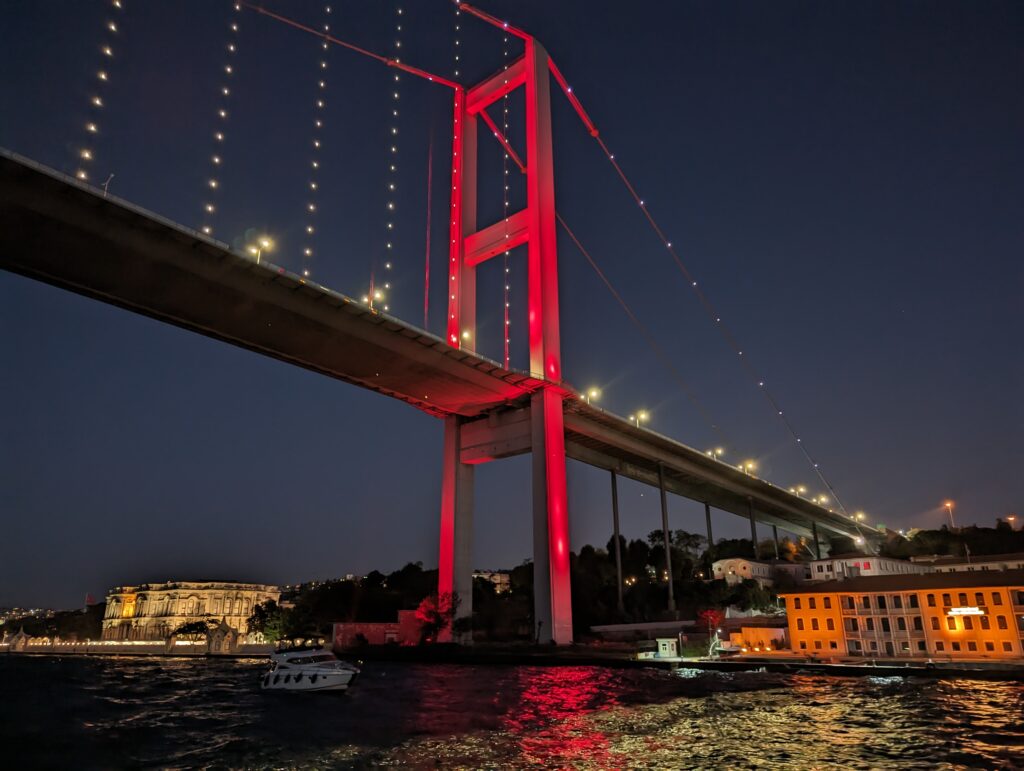
I haven’t crossed the Bosphorus Bridge, which is the first bridge on the Bosphorus strait. I travelled from Europe to Asia using the underground metro (which uses a tunnel) and the ferry. However, it is a very noticeable construction in the Istanbul landscape, and I got close to it during the sunset cruise.
Activities
Walking Tour
Walking tours are a nice way to discover some important landmarks, learn about the history of the city and its people, get some practical tips to navigate the city, and gather some recommendations for the rest of the stay. The free walking tour guides are usually great. They have often done the exact same circuit countless times. And, even if there is a suggested amount for tips, they have to earn them, and their performance (and the size of the group) greatly influences what they make.
We booked a free walking tour in Istanbul, the day after we arrived, with Free Istanbul Tour. We had a good experience, so I would recommend it. The guide carried a yellow umbrella, which is easy to spot. The tour started at 10:30 am close to Sultanahmet Square. The square stands on the Hippodrome of Constantinople, which has been completely covered today. However, the Obelisk is still standing. And you can see underneath the layers that have been added overtime.
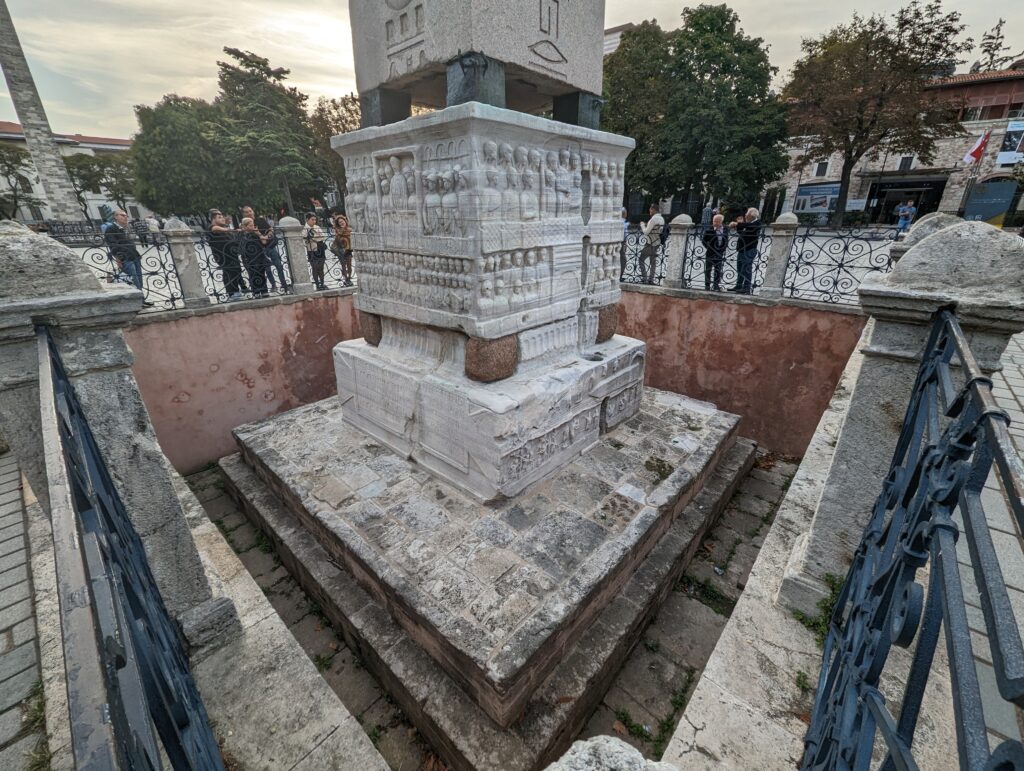
Blue Mosque
We moved to the courtyard of the Blue Mosque, constructed between 1609 and 1617. We did not queue to get in, and came back by ourselves in the afternoon. It gets its name from the blue Iznik tiles and the blue floral motifs. We were expecting something more overwhelmingly blue.
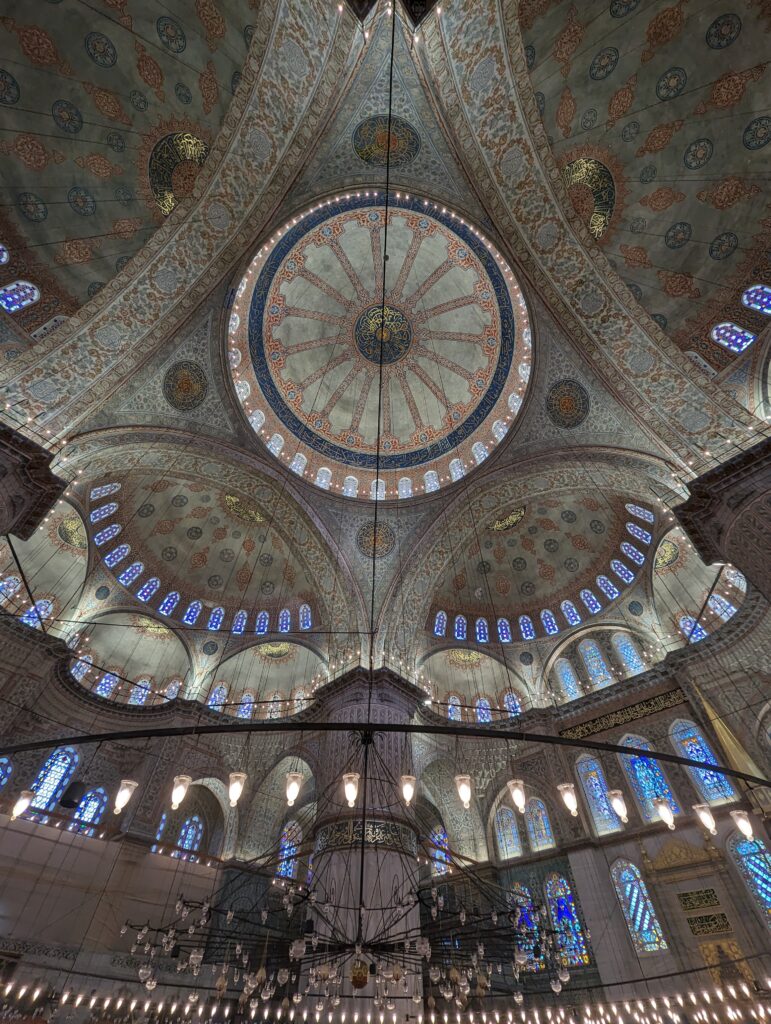
Hagia Sophia
Similarly, we did not enter Hagia Sophia until later in the afternoon. When the building was completed in 537 AD, it was the cathedral of Constantinople. It became a mosque when the Ottoman Empire seized Constantinople in 1453. Then, Atatürk decided to convert it into a museum in 1935. Finally, in 2020, it was converted back to a mosque. Good news! Mosques are free to visit.
When it was built, the pendentive dome, a circular dome above the square room, was an architectural masterpiece.
Twenty years ago, Hagia Sophia was probably the only Istanbul building I could list. It has a special place in the French history books I studied. So finally visiting it felt special, as if I could feel the history that has taken place inside these walls.
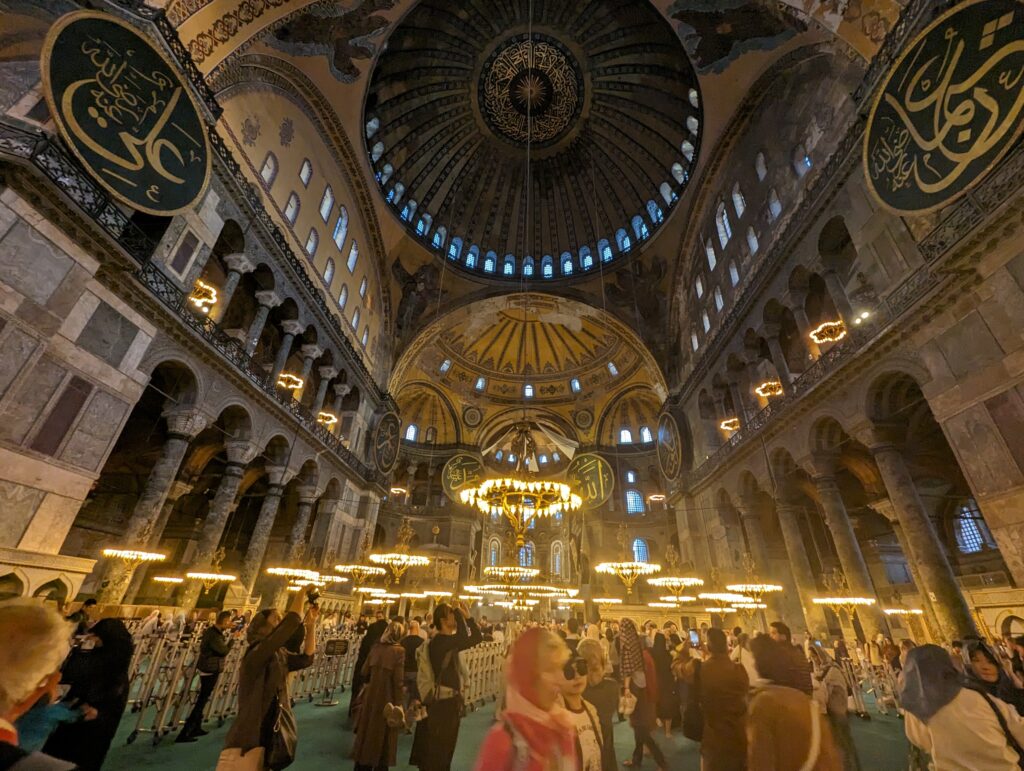
Grand Bazaar

The Grand Bazaar is a very large, mostly covered market, with thousands (3000-4000) of shops. It has (around) 21 gates with security portals, but guards do not really care about the alarms. It can be compared to a labyrinth, it is difficult to navigate, but it’s not oppressing since the 66 indoor streets are large and bright.
We were ordering food at Aynen Kebab when a young and charismatic local helped us complete the order. Since there was no seat available, he invited us to sit at his shop. When we got there, he gathered a table and two chairs on the street next to the shop. He got us some ayran, a yogurt-based drink with water, and salt, and offered soda and tea as well. We accepted the ayran and declined the rest because I was a bit uncomfortable with so much hospitality from a stranger. His family has a coin collection business in the Grand Bazaar.
Ortaköy
During the Bosphorus Cruise, we were impressed by the Grand Mecidiye Mosque (Ortaköy Mosque). From the ship we had a beautiful view at the large windows and light structure reaching high. We decided to come back to visit it. It is definitely less impressive from the land. Around the mosque, there are many shops selling Kumpir at exactly the same price : 200 liras (6.8 euros). They refused to negotiate, so we decided to try kumpir on Istiklal where we saw better prices.
Then, we walked to Yildiz Park, which was recommended by our hotel manager, who was a tourist guide for decades. The park is really nice and has a beautiful view on the summer palace.
Beyoğlu
İstiklal Caddesi is an avenue going from the Galata Tour to Taksim Square. There are nostalgic tramways running in the middle of it.
We had Kumpir and Ekmek kadayıfı on Istiklal.
Spice Bazaar
Bosphorus Cruise
Topkapi Palace
Karaköy
We had some delicious baklava in Karaköy Güllüoğlu. I recommend trying Soğuk Baklava (meaning cold baklava), which is a creamy version. Its ancestor is the Sütlü Nuriye where the syrup is replaced with milk.
Kadıköy
Balat and Fener
Next time we are in Istanbul, we will make sure to visit the Basilica Cistern and the Dolmabahçe Palace. Even if the Basilica Cistern was recommended on multiple occasions by trusted parties, I researched it extensively and ended up not going this time.
- Kaidor, CC BY-SA 3.0 https://creativecommons.org/licenses/by-sa/3.0, via Wikimedia Commons ↩︎
Leave a Reply